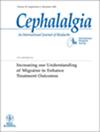Identification and characterization of migraine in pregnancy: A Norwegian registry-based cohort study
IF 5
2区 医学
Q1 CLINICAL NEUROLOGY
引用次数: 0
Abstract
BackgroundMigraine is common in women of reproductive age. Migraine’s episodic manifestation and acute and preventive pharmacological treatment options challenge studying drug safety for this condition during pregnancy. To improve such studies, we aimed to develop algorithms to identify and characterize migraines in electronic healthcare registries and to assess the level of care.MethodsWe linked four registries to detect pregnancies from 2009–2018 and used three algorithms for migraine identification: i) diagnostic codes, ii) triptans dispensed, and iii) a combination of both. We assessed migraine severity using dispensed drugs as proxies. ICD-10 diagnostic subcodes of migraine (G43) allowed the allocation of four subtypes: complicated and/or status migrainosus; with aura; without aura; other/unspecified.ResultsWe included 535,089 pregnancies in 367,908 women with available one-year lookback. The prevalence of migraines identified was 2.9%–4.3% before, and 0.8%–1.5% during pregnancy, depending on algorithm used. Pregnant women with migraine were mostly managed in primary care.ConclusionsPrimary care data in combination with drug dispensation records were instrumental for identification of migraine in electronic healthcare registries. Data from secondary care and drug dispensations allow better characterization of migraines. Jointly, these algorithms may contribute to improved perinatal pharmacoepidemiological studies in this population by addressing confounding by maternal migraine indication.妊娠期偏头痛的识别和特征描述:一项基于挪威登记处的队列研究
背景偏头痛在育龄妇女中很常见。偏头痛的发作性表现以及急性和预防性药物治疗方案给孕期药物安全性研究带来了挑战。为了改进此类研究,我们旨在开发算法来识别和描述电子医疗登记中的偏头痛,并评估护理水平。方法我们将四个登记处联系起来,以检测 2009-2018 年间的妊娠情况,并使用三种算法来识别偏头痛:i) 诊断代码;ii) 所配发的曲坦类药物;iii) 两者的组合。我们使用已配药物作为替代物来评估偏头痛的严重程度。通过 ICD-10 偏头痛诊断子编码(G43),我们可以划分出四个亚型:复杂性和/或状态性偏头痛;有先兆;无先兆;其他/未指定。根据所使用的算法,怀孕前偏头痛的发病率为2.9%-4.3%,怀孕期间为0.8%-1.5%。结论初级医疗数据与配药记录相结合,有助于在电子医疗登记中识别偏头痛。来自二级医疗机构的数据和配药记录可以更好地描述偏头痛的特征。联合使用这些算法可以解决产妇偏头痛适应症的混杂问题,从而有助于改进围产期药物流行病学研究。
本文章由计算机程序翻译,如有差异,请以英文原文为准。
求助全文
约1分钟内获得全文
求助全文
来源期刊

Cephalalgia
医学-临床神经学
CiteScore
10.10
自引率
6.10%
发文量
108
审稿时长
4-8 weeks
期刊介绍:
Cephalalgia contains original peer reviewed papers on all aspects of headache. The journal provides an international forum for original research papers, review articles and short communications. Published monthly on behalf of the International Headache Society, Cephalalgia''s rapid review averages 5 ½ weeks from author submission to first decision.
 求助内容:
求助内容: 应助结果提醒方式:
应助结果提醒方式:


